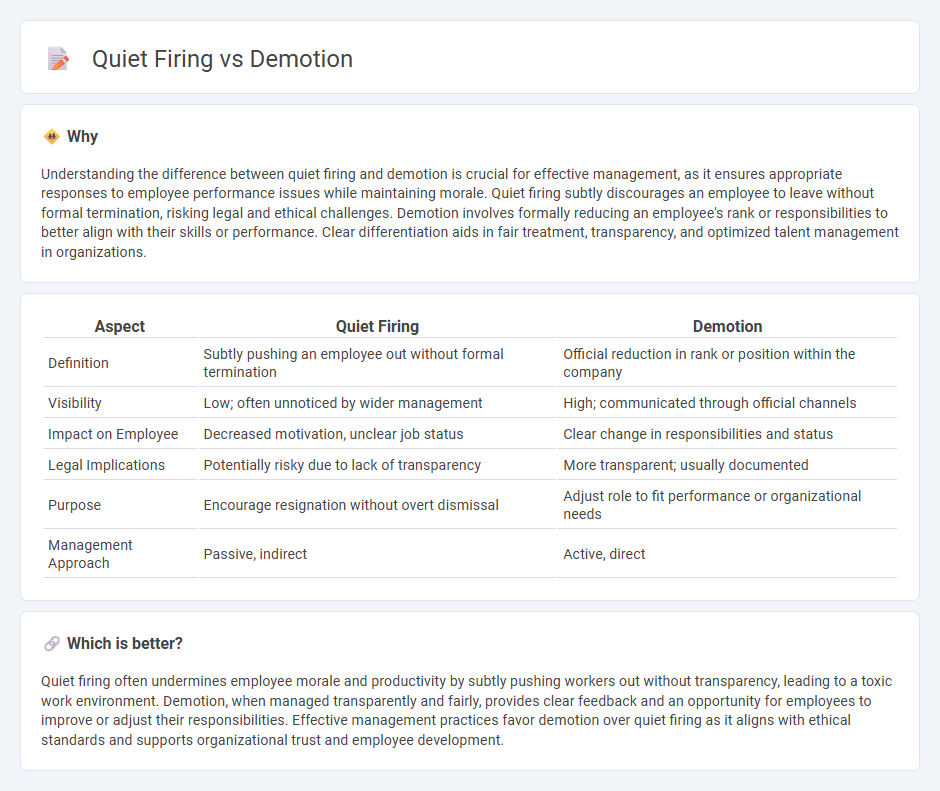
Quiet firing subtly undermines employee performance and motivation through gradual neglect, contrasting with demotion, which is a formal, transparent reduction in rank or responsibilities. Both tactics impact workforce dynamics differently, with quiet firing often leading to disengagement and demotion prompting clear organizational restructuring. Explore the nuances and implications of these management strategies to better understand their effects on employee relations.
Why it is important
Understanding the difference between quiet firing and demotion is crucial for effective management, as it ensures appropriate responses to employee performance issues while maintaining morale. Quiet firing subtly discourages an employee to leave without formal termination, risking legal and ethical challenges. Demotion involves formally reducing an employee's rank or responsibilities to better align with their skills or performance. Clear differentiation aids in fair treatment, transparency, and optimized talent management in organizations.
Comparison Table
| Aspect | Quiet Firing | Demotion |
|---|---|---|
| Definition | Subtly pushing an employee out without formal termination | Official reduction in rank or position within the company |
| Visibility | Low; often unnoticed by wider management | High; communicated through official channels |
| Impact on Employee | Decreased motivation, unclear job status | Clear change in responsibilities and status |
| Legal Implications | Potentially risky due to lack of transparency | More transparent; usually documented |
| Purpose | Encourage resignation without overt dismissal | Adjust role to fit performance or organizational needs |
| Management Approach | Passive, indirect | Active, direct |
Which is better?
Quiet firing often undermines employee morale and productivity by subtly pushing workers out without transparency, leading to a toxic work environment. Demotion, when managed transparently and fairly, provides clear feedback and an opportunity for employees to improve or adjust their responsibilities. Effective management practices favor demotion over quiet firing as it aligns with ethical standards and supports organizational trust and employee development.
Connection
Quiet firing and demotion are interconnected management strategies used to indirectly signal an employee's declining performance or fit within the organization. Quiet firing involves reducing responsibilities, limiting opportunities, and withholding support without formal termination, often leading to decreased employee morale and productivity. Demotion formalizes this by officially lowering an employee's rank or responsibilities, which frequently follows the subtle disengagement tactics characteristic of quiet firing.
Key Terms
Performance Evaluation
Demotion involves a formal reduction in rank or responsibilities based on documented performance evaluations, often accompanied by clear communication and objectives for improvement. Quiet firing refers to subtle tactics like reduced assignments or exclusion from key tasks, indirectly signaling dissatisfaction without explicit performance feedback. Explore the nuances of performance evaluation in both approaches to understand their impact on employee morale and career progression.
Employee Morale
Demotion directly impacts employee morale by signaling potential underperformance and altering job responsibilities, often causing decreased motivation and engagement. Quiet firing subtly undermines morale by gradually removing opportunities and support, leading employees to feel undervalued and uncertain about their future. Explore effective strategies to maintain morale and address these challenges in your workplace.
Organizational Policy
Demotion involves formally reassigning an employee to a lower position with clear documentation aligned with organizational policy, ensuring transparency and due process. Quiet firing, often characterized by creating unfavorable work conditions to encourage voluntary resignation, typically lacks official acknowledgment, raising ethical and legal concerns. Explore comprehensive organizational strategies to distinguish appropriate disciplinary measures from covert employment practices.
Source and External Links
Demotion - Wikipedia - A demotion is a compulsory reduction in an employee's rank or job title, often involving loss of privileges or salary, usually due to factors like poor performance, misconduct, or organizational financial difficulties; it differs from a lateral move or voluntary step down.
HRAR-7.03 - Demotion - Portland.gov - Demotion occurs when an employee is placed in a position with a lower maximum salary rate, which may be involuntary for cause or voluntary by written request, and typically involves approval processes and probationary conditions if the position was not previously held.
What Demotions at Work Mean for Employees and Managers - Indeed - A demotion involves reducing an employee's job title, duties, or role often due to low performance, disciplinary issues, budget cuts, or company restructuring, and can be temporary or permanent as an alternative to termination.
 dowidth.com
dowidth.com